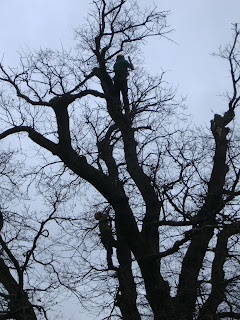It is
now early January 2017. Mountains of Christmas trees are being brought to Mayow
Park to be shredded. It is great to see in the post-Christmas period that so
many people are bringing them to the recycling areas in the park. Glendale
workers have been busy chipping them and, despite the noise of the shredding machine, their efforts have been much appreciated.
 |
| Glendale tree chipping in progress |
 |
| Glendale machine eats Christmas trees |
But the
shredding machine is driven by diesel fuel. With concern growing about diesel
emissions being bad for human health, is it time to rethink and modify this
tradition?
This relatively modern, supposedly Christian, festive tradition may have originated in Germany. Although it became a ‘Christian’ tradition it has nothing to do with Christianity; trees brought into the home and decorated during the midwinter can be traced to pagan traditions.
What about environmental questions relating to real versus artificial trees: Do real
Christmas trees, grown on plantations, cut down, transported, put on display in
our homes and in public spaces, then taken away for shredding using fossil-fuelled
machinery, have a smaller environmental impact than artificial trees which are
brought out of storage every year for two decades or more?
Artificial
Christmas trees are usually made from PVC (polyvinyl chloride), which is a
plastic derived from petrol. It is non-renewable. It is not recyclable. It
gives off toxins including dioxins which are hazardous to human health. Is it
true that you need to reuse the tree for twenty years before its environmental
impact becomes less than a cut previously-living tree?
Farmed
and harvested biodegradable Christmas trees, used for a couple of weeks then
taken to our parks for shredding after Christmas, still have an environmental impact. Farming
produces emissions. Transportation produces emissions. Using diesel or other fossil
fuel for shredding produces emissions.
The least
environmentally damaging tree solution could be a conifer or another type of
tree growing in a suitable pot outdoors which can be brought into the house
every December and returned to the outdoors immediately after Christmas.
Any thoughts?






